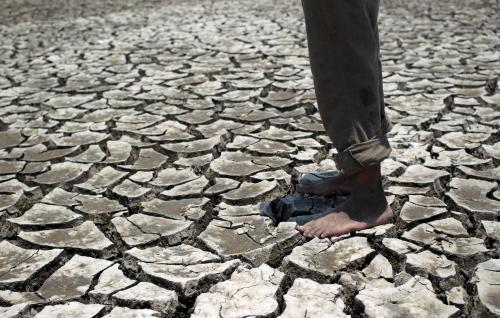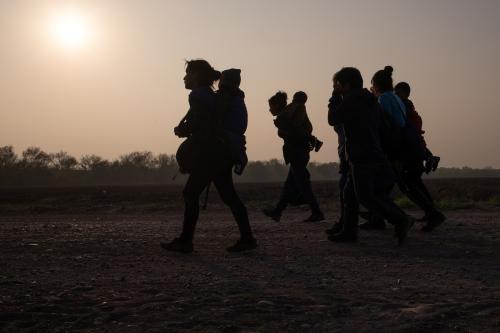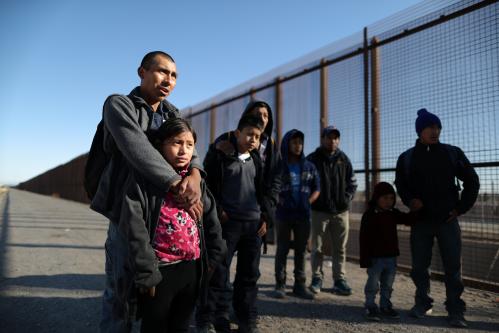Annual apprehensions of people from Guatemala arriving in family units at the U.S. southern border grew exponentially between 2012 and 2019—from just 340 to a whopping 185,134 (Figure 1). As a proportion of total Guatemalan apprehensions, those apprehended as family units grew from less than 5 percent to 70 percent in the same period. This increase happened before the pandemic, before the 2020 hurricanes that devastated parts of Central America, and before President Biden was elected. The underlying conditions driving migration predate these events and still exist today and—without an adequate policy response—seem set to continue.
Family migration from Guatemala to the U.S. is associated with rural poverty and agricultural stress linked to climate change, as we show in our new policy brief. Using data on apprehensions at the U.S. border, we explore the subnational areas of greatest out-migration from Guatemala. Increasing agricultural resilience to climate change, tackling rural poverty, and improving internal migration options will be the main components for providing viable domestic alternatives for Guatemalans who currently view migration as a necessity.
 Source: Duke Sanford Center for International Development, 2022.
Source: Duke Sanford Center for International Development, 2022.
Unchanging poverty, changing climate
Almost half of all people in Guatemala live in poverty and, the poverty rate rises to nearly 80 percent for indigenous people, who make up more than 40 percent of the country’s population. Guatemala has the highest levels of childhood stunting in Latin America and the sixth highest in the world, with rates in rural and indigenous communities more than 50 percent higher than national averages. Frequent droughts linked to climate change in the Dry Corridor have significantly affected the agriculture sector, which employs one-third of Guatemalan workers.
Our analysis links data on department (state) of birth for Guatemalan family unit apprehensions to subnational measures of agricultural stress, percent of the population that lives in rural areas, wealth, and homicide rate. Our study of family unit apprehensions complements prior work on migration from Guatemala based on survey research and in-depth interviews.
The three departments with the highest numbers of apprehensions are Huehuetenango, Quiché, and San Marcos—all located in the Western Highlands. The rural population in these departments ranges between 68 percent and 75 percent of total department population. Seven percent of the population of Huehuetenango was apprehended at the U.S. southern border as part of a family unit during this time, the highest percentage of any department. This finding coincides with recent work documenting extensive migration from Huehuetenango to the United States.
Our results show that a higher share of rural population in a department is associated with more family migration. An increase in the percent of people in a department living in rural areas from 37 percent (10th percentile) to 60 percent (75th percentile) is associated with a 136 percent yearly increase in apprehensions—from 29 to 69 per 100,000 population.
We use an indicator of agricultural stress for cropland from the Food and Agriculture Organization that is available at the department level and functions as an early indicator of high likelihood of drought. According to our analysis, a change in the value of agricultural stress from 0 percent of cropland affected to 9 percent affected is associated with an increase in the department’s apprehension rate from 31 to 57 people per 100,000 population the following year. If 24 percent of cropland is under agricultural stress (95th percentile in our data), average apprehensions for the department rise to 62 per 100,000 population—double the baseline scenario.
Our analysis shows that higher levels of homicides per capita are associated with increased apprehensions in some areas of the country. When the homicide rate increases from the 10th percentile to the 75th percentile in departments outside of the Dry Corridor, the apprehension rate increases by 72 percent. There is no significant correlation between homicides and apprehensions for departments in the Dry Corridor, consistent with the interpretation that rural poverty and agricultural stress linked to climate change are more important drivers of migration from this region.
These findings do not capture the indirect impact of violence on migration. People who leave their homes have a choice to migrate internally or externally. High levels of violence in some Guatemalan cities, control of parts of the country by drug trafficking organizations and gangs, and increasing rates of extortion, along with factors such as strong ties to the U.S. from previous migration, help explain why only a small percent of Guatemalans see internal migration as desirable.
Getting at the root causes
The Biden administration has proposed $4 billion in U.S. foreign aid to Central America to address the root causes of migration. Figure 2 shows previous U.S. aid to Guatemala, with a relatively small percent devoted to agriculture. Experts argue that increased funding for smallholder farmers and investing in the evolution of food systems in the region are key components to providing sustainable futures in rural areas of Guatemala and to improving agricultural resilience to climate change. Considerable rural investment will be necessary to reduce the pressure on families to migrate.
 Source: Duke Sanford Center for International Development, 2022.
Source: Duke Sanford Center for International Development, 2022.
This investment will require progress in rooting out the intractable and interacting scourges of corruption, drug trafficking to meet demand in the U.S., gang violence, and the flow of guns into Central America from the U.S. market. Donors should consider working directly with local groups to build capacity and increase the impact of aid. Well-designed programs can decrease the need to move and increase the feasibility of internal migration options, while waiting for long-term solutions to economywide problems. Broader employment-based pathways for migration would lower the demand for human smugglers, decrease the exploitation of migrants, and cut the profits for organized criminal groups. Purposeful design could create mutually beneficial bilateral labor agreements between Central American countries and the United States, enhancing benefits of migration both for sending and receiving countries.







Commentary
Rural poverty, climate change, and family migration from Guatemala
April 4, 2022